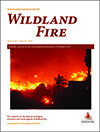International Journal of Wildland Fire
Volume 30
Number 10 2021
In Indonesia, many actors or bureaucracies are involved in managing forest fires. However, the state apparatus or bureaucracy cannot properly address occurrences. Consequently, based on these factors and their context, it is necessary to change this bureaucratic inertia problem by making policy recommendations for the short, medium and long term.
Through cross-cultural monitoring, Indigenous rangers and non-Indigenous scientists found that Indigenous cultural burning had less impact than wildfire on reproductively mature, threatened backwater grevillea. Fuel load decreases resulting from cultural burning, hazard reduction and wildfire were similar, although the cultural burn resulted in less severe fire effects than other fires.
The area burned in California wildfires has increased steadily in California since the late 1970s, and the trend appears to be accelerating. The same accelerating trend is seen with area burned in the wildland–urban interface and total structure damages. Recent catastrophic wildfires in California are part of a long-term trend towards increasingly large and destructive wildfires.
Potential model theory and artificial neural networks were used to analyse the relationship between spatial accessibility of anthropogenic fire ignition sources and grassland fire pixels. The results showed that the spatial accessibility of residential area, roads and cultivated land emphasises the ignition risk of grassland fire.
We investigate the effect of fuel data resolution on 2D fire behaviour models, showing model outcomes are similar at resolutions greater than the connectivity length scale of the fuel but are strongly affected at resolutions below this threshold.
We propose a methodology to quantify the forecast uncertainty in wildfire spread simulation relative to the resolution and we analyse its sensitivity to computational parameters. The results suggest that the uncertainty increases with coarse resolution and is mostly affected by the fire spreading regime and its interaction with the atmosphere.
This study aimed to assess the wildfire danger for China based on a set of topography, weather and fuel variables, with particular emphasis in evaluating the role of two remotely sensed key fuel variables, fuel moisture content (FMC) and foliage fuel load (FFL), in the assessment.
 , Rijal Ramdani
, Rijal Ramdani  , Agustiyara
, Agustiyara  , Achmad Nurmandi
, Achmad Nurmandi  , Dina Wahyu Trisnawati
, Dina Wahyu Trisnawati  and Aqil Teguh Fathani
and Aqil Teguh Fathani 




